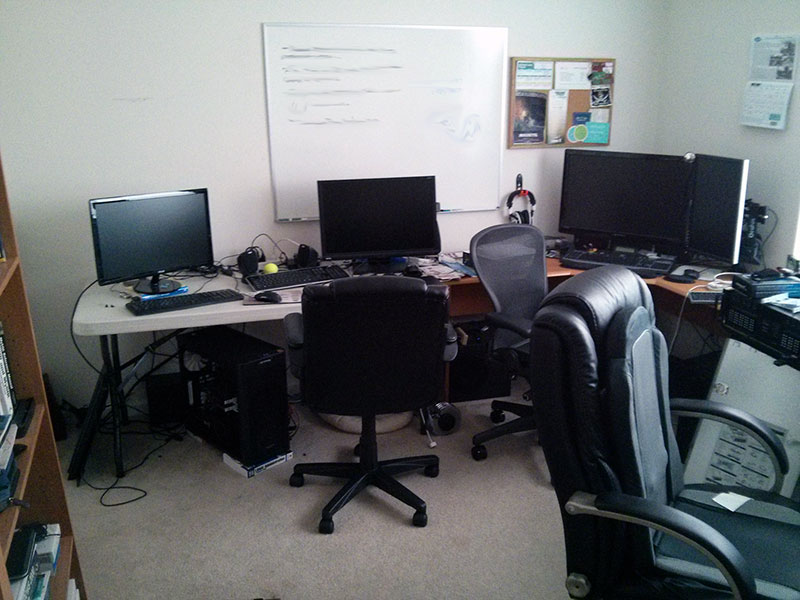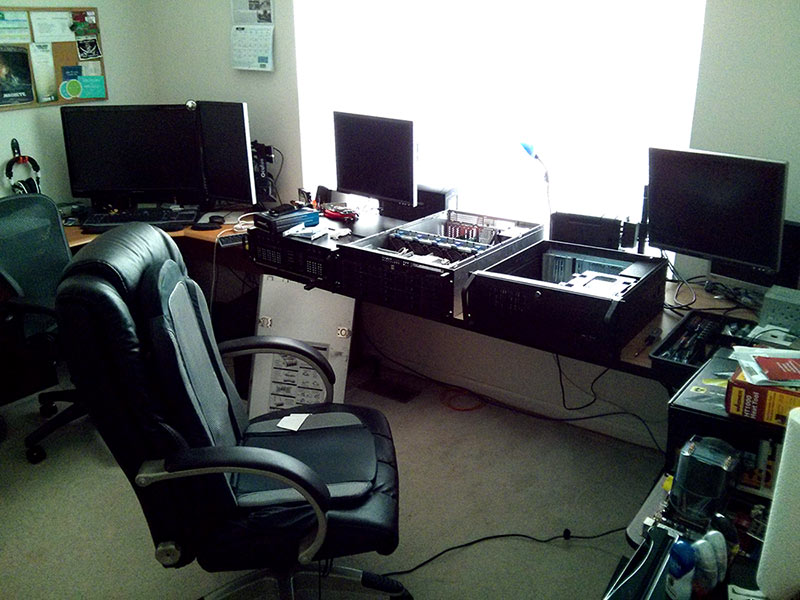-
Posts
512 -
Joined
-
Last visited
-
Days Won
8
Content Type
Profiles
Forums
Downloads
Store
Gallery
Bug Reports
Documentation
Landing
Posts posted by eschultz
-
-
Give this a shot:
location /lime/ { proxy_pass http://tower:80/; proxy_redirect http://tower:80/ /; } -
I attached the syslog after a reboot. The array is not started.
I have also attached the system specs from the info button on the web page
Thanks you
Move these two devices that are plugged in to your motherboard to different sata connections:
ST3000DM001-1CH166 Z1F47J81
ST3000DM001-1CH166 Z1F47J7N
There seems to be a driver issue with those two sata connections (maybe something's up with the ASMedia ASM1061 chip powering them) and unRAID is using a PATA driver instead of SATA.
-
Hi dlandon/eschultz,
Eschultz, if I follow your steps -but I run a second vm- when I close one of them Unraid will be closed (even is my other vm is still running), right? I am guessing this, since I cannot analyze your script due to my limited linux knowledge.
K/S scripts are an excellent option but I will need some time to learn how to wirte a script. I have not much time now for that. Have anyone tried them with kvm?
I think the best option for me now would be the basic powerdown script that -when power button is pressed- triggers the following commands: STOP the array + POWERDOWN the array. In this way I can use it only when I am sure all my VM´s have been previously closed. It will then close Unraid (so I can run a headless setup). I will try it.
Thx for support. Rgds.
If you're running multiple VMs but you only want to shutdown the whole system when your main windows VM is shutdown then here's the tweaked script from my prior post:
mkdir -p /etc/libvirt/hooks/ echo -e '#!/bin/bash \n[ "$1" = "win81vm" ] && [ "$2" = "stopped" ] && /usr/local/sbin/powerdown' > /etc/libvirt/hooks/qemu chmod +x /etc/libvirt/hooks/qemu
Just replace the win81vm string above with the actual name of your windows vm from vm manager.
So what does this script do? Well, when libvirt starts or stops a VM it'll look to see if the file /etc/libvirt/hooks/qemu exists, and if so, will execute it with some parameters:
/etc/libvirt/hooks/qemu <guest_name> <operation>
My script just checks if the guest_name is win81vm and the operation is stopped then run the special powerdown command for unraid. You can read about these hooks in detail from here: https://www.libvirt.org/hooks.html
-
Hi!
I am running 6b10a and I run a single VM with win8.1 as it´s OS. I have created the VM using kvm. I also use vmmgr (a a PHP libvirt-based Web interface for managing virtual machines created by dmacias) but I automated my Unraid and VM start to enable autostart.
My start sequence is: push unraid power button > array starts > array automounts shares > VM autostart. Nothing else is running in my lan.
How can I automate that when I close my VM also unraid unmounts my shares and Unraid safely shutsdown?
Any help is appreciated!
Rgds.
Just thought of this on the fly (not tested, aka AT YOUR OWN RISK!) but you could try these commands at the unRAID console / SSH session to setup a hook script to shutdown the host when a VM is stopped:
mkdir -p /etc/libvirt/hooks/ echo -e '#!/bin/bash \n[ "$2" = "stopped" ] && /usr/local/sbin/powerdown' > /etc/libvirt/hooks/qemu chmod +x /etc/libvirt/hooks/qemu
From there you can start your VM (if it's not already running) and then just shutdown windows. After windows completes its shutdown then the array should stop and the host machine should power off automatically.
If you ever needed to remove the hook script you could just run this from the unRAID console or SSH, before you shutdown windows VM of course:
rm /etc/libvirt/hooks/qemu
Also, if you need to manage the array (e.g. stop the array) you'll probably need to remove the script before doing so because stopping the array will normally stop libvirt (which would shutdown your VM and host machine).
-
SMB and NFS work a bit different when it comes to the path. NFS needs the full path.
SMB example: "smb:\\tower\sharename"
NFS example: "nfs://tower/mnt/user/sharename"
If it was for a Disk share (e.g. Disk1) instead of a User share then something like: "nfs://tower/mnt/disk1"
Hope that helps!
-
QEMU 2.2 (recently released) has improved the virtio-scsi passthrough so that may solve these issues. This will be included in one of the future beta versions.
-
Alright guys, you can call off your russian spam bots... we hear you loud and clear! We'll release unRAID 6 ASAP!

-
I seem to also be having a similar issue since upgrading to 6.0-beta10a/12.
I have a 3 AOC-SASLP-MV8's in my setup.
While on 6.0-beta10a, I recently swapped out my 4TB parity, with a 6TB red. Once parity rebuild was complete, I swapped out a 2TB disk with the 6TB and let it rebuild. Parity rebuilt the disk and expanded my array just fine. I then upgraded to 6.0-beta12 and have been fighting ever since. My data 6TB red drive red balled, but all checks on the disk show fine. And now my parity is showing invalid, even though the parity disk is green balled. If my situation is similar, I'd like to assist if I can, if it is not, I can start a new thread.
MisterLas, can you please verify that you have 3 of the AOC-SASLP-MV8 and not the AOC-SAS2LP-MV8 controller cards?
I have 2 AOC-SAS2LP-MV8 controller cards powering 14 drives (mixed 2TB and 3TB assortment) running Beta 12 and haven't had an issues with the parity (i've done parity checks too). What model of motherboard do you have?
-
So far so good. No memory allocation errors and no crashes of the VM or any plugins. The syslog is not showing any of the errors that had been so common before.
Feel a bit like I should have known better but all of the ram slots are the same colour and I never bothered to look at the superfine print on the board that says DR3_4, DR3_2, DR3_3, DR3_1 off to the side of the ram slots. Lesson learned. Won't be making that mistake again.
Thanks for the help.
Just to clarify, you now have a 4GB chip in slot DDR3_2 and another 4GB chip in slot DDR3_1? if so, and I believe you do, then you're now taking advantage of dual channel

-
Give this a try and let me know if it helps you. Either way, if it helped or not, let me know which cpu you tried with this command:
I am running in plain unRAID mode and changing the driver does work for me; using an Intel Core i3-4130T processor.
It used to stay at max frequency all the time (I could see it drop to lower frequencies for very short periods), now it nicely scales down as it used to do.
I also have an i3-4130T so I figure this fix will solve the issue for me as well. Will report back later when I can try this out.
Is the driver issue something which can/will be fixed in the next update? I don't mind implementing this quick fix, but I'd love it if I didn't have to.
Too early to tell. Know that we would like to avoid this workaround as well. The main purpose of providing it was to ensure that it results in a fix for folks and to see which processors are affected.
I think the kernel 3.18 or 3.19 has even more changes for the Intel pstate drivers. I can't recall exact details but do remember seeing it on the list when I was reading about latest Linux roadmaps.
I don't think we should jump to kernel 3.18 as it just hit and always seems to take a couple of release patches to get things running smoothly again. But just wanted to let everyone know how it seems to be a work in progress, though I'm sure the limetech folks already know this.
Our current beta12 has kernel 3.17.4 and our next beta (still under development), Beta13, will be upgraded to kernel 3.17.6. For kicks I tried Kernel 3.18 a couple days ago and the intel_pstate driver situation wasn't improved in either new kernel versions. I probably need to roll back to beta10a (kernel 3.16.3) and see if that intel_pstate driver works on my test systems and review the kernel code changes between now and then. I'm doubtful the next beta will include a intel_pstate fix since we're working to wrapping it up for you guys... there are 25-30 fixes and new features in Beta13.
Thanks to everyone so far on reporting back the cpu. I'll be keeping a list of cpu's affected by the intel_pstate driver and try to find the code to blame in the kernel.
-
In KVM mode, there might be a cpu scaling driver issue with certain hardware combinations. One of those drivers is called Intel-Pstate. This is the chosen driver if your Intel cpu is Sandy Bridge (2011) or newer. On my Haswell-class cpu (i7-4771) the Intel-Pstate driver is too sensitive and seems to keep the cpu frequency near the max frequency even when idle but occasionally it does scale the frequency down.
You can disable the Intel-Pstate driver by editing your /boot/syslinux/syslinux.cfg and adding a intel_pstate=disable parameter to the append line below:
...
label unRAID OS
menu default
kernel /bzimage
append intel_pstate=disable initrd=/bzroot
...
Save the file, stop the array and reboot unRAID. Doing this on my Haswell machine caused it to use the acpi-cpufreq scaling driver instead of the intel_pstate one. It scales the frequency down like a rockstar now! Usually keeps it around 800MHz - 1000MHz during idle now.
On the flip side, my other test machine, a year older Intel cpu (i5-3470) was able to scale down to 1600MHz (minimum) pretty consistently when using the intel_pstate driver... but when I disabled intel_pstate then there wasn't a scaling driver available. For some reason the acpi-cpufreq driver wasn't compatible with this cpu. Your mileage may very.
Give this a try and let me know if it helps you. Either way, if it helped or not, let me know which cpu you tried with this command:
grep -m 1 'model name' < /proc/cpuinfo
-
My server just rebooted again for no reason. I'm going to change the logging again to try to figure out why. As much for myself in the future as anything else, here are the steps for making this change...
mkdir -p /mnt/cache/logs touch /mnt/cache/logs/syslog nano /etc/rsyslog.conf Change *.debug -/var/log/syslog to *.debug /mnt/cache/logs/syslog save changes /etc/rc.d/rc.rsyslogd restart logger -ttest test message verify it's writing to syslog on cache
Hopefully persistent logging gets added to unRAID soon.
Well, actually you can persist your /etc/rsyslog.conf if you copy it to /boot/config/rsyslog.conf
I built and pushed for the upgrade to rsyslog because there's a few really neat things we can do with it over the original syslog shipped with slackware. More to come down the road with this after 6.0 is out the door. For now that little gem will persist your rsyslod across reboots (and capture the entire log starting from system boot to output to your intended target log location). The check for (and copy of) /boot/config/rsyslog.conf to /etc/rsyslog.conf happens right before the rsyslogd service is started up during the boot process.
-
I saw the original posts in the announcement thread and then here, but nothing seems to have been confirmed either way.
So, is this a thing, or just a reporting issue?
On my system it is a dynamix reporting bug.
The system is switching frequencies and mostly hovers at the lowest speeds. Dynamix always shows the max frequency.
cat /proc/cpuinfo |egrep -i mhz
cpu MHz : 1697.078
cpu MHz : 1699.070
cpu MHz : 1646.078
cpu MHz : 1686.453
cpu MHz : 1598.000
cpu MHz : 1605.968
cpu MHz : 1688.445
cpu MHz : 1620.179
Are you in KVM or Xen mode? These stats won't be accurate with Xen mode in the current beta.
Behind the scenes the dashboard CPU stats are pulled using this command:
awk '/^cpu MHz/ {print $4*1" MHz"}' /proc/cpuinfo -
Unable to boot xen
Failed to load libcom32.c32
Failed to load COM32 file /syslinux/mboot.c32
boot:
same error here fresh download, fresh install, multiple drives that unraid 6 worked on before
Failed to load libcom32.c32
Failed to load COM32 file /syslinux/mboot.c32
I did a fresh install of beta 12 and when i try to boot with xen/unraid os option
i get an error
Failed to load libcom32.c32 Failed to load COM32 file /syslinux/mboot.c32
And it reboot after that.
Please download the attached zip and extract it to your flash drive's /syslinux/ folder. It contains the missing libcom32.c32 file which will be included in the next beta release.
-
It seems that the update to the webGui has broken the docker plugin.
Unable to start any of my installed containers.
The Docker page now looks like the image.
Kevin
[Edit] All the status/log pages return blank.
Please remove the DockerMan plugin under the Plugins tab. It's no longer needed (and actually causing a conflict).
-
Hi
latest changes syslinux something broke with boot without GPU

Im using mainboard without GPU with CPU also without GPU and i get from ASROCK special moded bios for possible boot up without GPU
but i was using parametr CONSOLE 0
CONSOLE flag_valIf flag_val is 0, disable output to the normal video console. If flag_val is 1, enable output to the video console (this is the default.) Some BIOSes try to forward this to the serial console which can make a total mess of things, so this option lets you disable the video console on these systems.
And i add to kernel parametr
kernel /bzimage console=ttyS0,9600n8
for redirect console on serial, after that changes UNRAID run/boot without problem
but now after updated syslinux just stop on first line with SYSLINUX version

(i just revert only syslinux folder on flash from beta10a and start working again)
This will be difficult for us to test but I'm curious if you used Windows or Mac to 'make bootable' the flash device with the new syslinux? Also, What is the exact model of your Asrock motherboard?
-
I kinda wanna punch something right now.
I uninstalled all nvidia drivers/software from my VM
I removed the GPU and HD Audio lines from qemu
I rebooted the VM, and verified it started fine, and that there was only one VGA and no HD Audio devices, and no yellow triangles.
I shut down the server
I ran another HDMI cable from the iGPU to another input on the TV
I changed the BIOS to default to the iGPU
I started unRAID
I watched it boot on the iGPU
I then removed the graphics and video sections fro the XML
I added the GPU and HD Audio lines back to the qemu section of the XML
I started the VM
viola, windows was booting on my TV on the input connected to the 550Ti
I noticed a warning that Avast wasn't running, and I was unable to start it. Weird, but okay, whatever
I tried to go to printers and devices to see my bluetooth dongle, and pair my keyboard. printers and devices never opened.
Oh well, I still need to install the nvidia drivers for the GPU and HD Audio, so I did that. Went just fine. Told me I needed to reboot, I did
Windows never came up again on the TV!!!!
So, it's either a problem with nvidia drivers (I'm using latest WHQL version - 344.48 and only installing graphics, audio and physics drivers; no 3D or experience drivers installed)
Or it's a problem with rebooting the machine.
I'm going to shut down the server, and try one more time from a fresh boot, then I'm off to bed.
After testing tonight on my 550ti I'm having about the same issues. I believe this card is having an issue "resetting". So this basically means anytime you want to restart the Win7 VM you'll need to reboot the whole host at this point.
-
Now where are the pictures of the people working with all of those machines around them?
we're... ah... waiting for compile to finish

-
Don't forget all the office hardware too...


-
OpenVPN Server
OpenSSH
BTSync
MySQL Server
CrashPlan
CouchPotato v2
SABnzbd
SickBeard
Cache Directories
APC UPS Daemon
-
-
root@fileserver:/boot# dskt.sh X p r q s
Brandon, can you please post your dskt.sh script or at least point me to where I can grab it? I'd like to benchmark a few of my controllers.
Thanks!


CPU freq not stepping down
in Defect Reports [DEPRECATED]
Posted
Just a quick update: Last week I was able to track down the exact commit in the kernel that's causing the frequency issues on haswell-based cpus using the intel_pstate driver. I created a kernel patch for Tom so, with his blessing, might actually make it in the next beta. I also shot an email to the commit author at Intel to get his feedback on the situation and my findings.